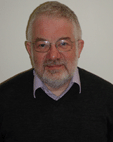DOI: 10.1039/C1CC90194J
(Profile)
Chem. Commun., 2012, 48, 1622-1622
Interview with Alexander Blake
| ||||||
Do you remember what it felt like to publish your first ChemComm article?
Getting this paper (DOI: 10.1039/C39860000334) published was an achievement but it has probably made more of an impression on me in retrospect. It was our first publication about a macrocyclic complex but many more of these followed in the next few years, notably a major series of papers about metal complexes of thioether macrocyclic ligands.How has your research evolved from your first to your most recent article?
Scientifically we can trace some of the work we publish now back to its roots in our earliest published work in ChemComm, but in many ways the content and the experience are totally different. Papers now tend to contain a higher density of significant results, with results that would once have merited inclusion in the main paper now relegated to the Supplementary Information. This is not necessarily a bad thing, just very noticeable.What do you like most about publishing in ChemComm?
The emphasis on scientific quality and the input from reviewers—even when they are wrong! Also the fact that colleagues pay attention to what appears in ChemComm.What aspect of your research are you most excited about at the moment?
It has to be our work in high pressure crystallography of coordination complexes. The work I've mentioned on thioether complexes raised some intriguing structural questions—we couldn't tackle these at the time but we never forgot them. What was the third sulfur donor in the tridentate macrocycle doing when it wasn't needed to complete the coordination sphere? Could its position be manipulated? We found out the answers and a lot more. At a pressure of 44 kbar the orange mononuclear Pd(II) complex cis-[PdCl2([9]aneS3)] ([9]aneS3 = 1,4,7-trithiacyclononane) converts into an intensely black chain polymer, which now has distorted octahedral coordination at the metal centre and an unprecedented [1233] conformation for the thioether ligand. These results appeared on the front cover of ChemComm in 2006 (DOI: 10.1039/B606736K), and this supported successful applications for studentships, dedicated equipment and access to central facilities. We are now engaged in a search for new phenomena using high pressure crystallography and have recently discovered unprecedented types of interactions, transformations and dependencies.What is the best part of your job?
Making new discoveries and working collaboratively with colleagues and students.What is the secret to success in scientific publishing?
Having a good idea, or at least a question; having a good story to tell; choosing a journal/readership and writing for them.What is your advice to young emerging scientists?
See above. Also, don't be afraid to ask colleagues for advice and feedback.What do you do in your spare time?
Theatre, films; trying to keep up to date with emerging technology, but I'm not really an “early adopter”.By the time I'm 100 I would like to have…
…seen at least initial human habitation of the Moon and Mars. I think one of the real disappointments of the late 20th Century was the abandonment of much of what was possible in space exploration. There's a lot of chemistry out there as well.| This journal is © The Royal Society of Chemistry 2012 |

